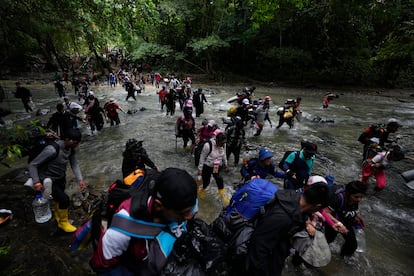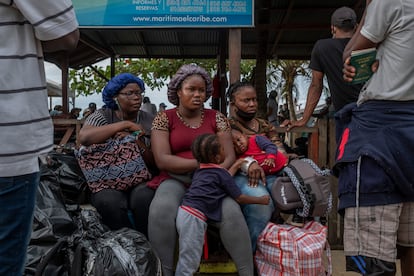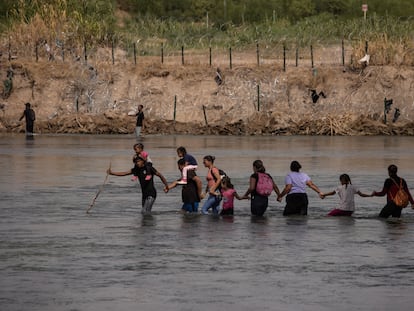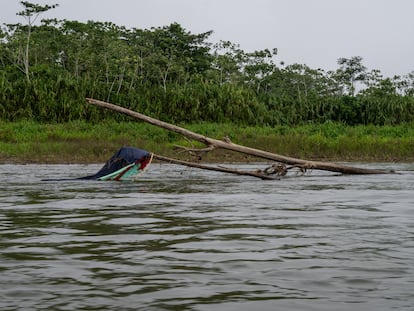A three-month wait: New US immigration plan marred by secrecy and uncertainty
Safe Mobility offers legal routes to North America from Colombia, Costa Rica and Guatemala. However, migrants have nowhere to go to obtain access and complain of being forced to sign confidentiality agreements

Secret offices, weeks of waiting, calls from private numbers and confidentiality agreements. These are some of the features of the new U.S. immigration program known as Movibilidad Segura, or Safe Mobility, which pursues “the expansion of legal routes to the United States or other countries for refugees and migrants in South and Central America,” according to its official website. The United States launched the program in June with the aim of “reducing irregular migration,” and established migration offices in Colombia, Costa Rica and Guatemala. However, three months after its launch, less than 1% of the nearly 29,000 applicants in Colombia have passed through the U.S. Refugee Admissions Program (USRAP), according to official data. The lack of information and the secrecy surrounding the project have experts consulted by EL PAÍS perplexed, and tens of thousands of migrants trapped between hope and uncertainty.
The application process for Safe Mobility initially sounds straightforward, yet Venezuelan Eliezer Briceño explains by video call that in reality it is not. “It’s tedious,” says the 40-year-old Caracas native, who registered on August 11 with his wife and 8-year-old son on the official website. He succeeded on his second attempt, after failing to do so on his cell phone. “The website is not so user-friendly. Anyone who doesn’t have good technological equipment won’t be able to sign up quickly. Also, you have to have a good internet connection because the site is slow,” he says.
The website is currently closed in Colombia since it has been overloaded with applications. It will reopen on October 10, a spokesperson for the U.S. Embassy in charge of the program told EL PAÍS. The available quotas were filled quickly, in the two periods lasting only a few weeks that have been open since the launch.

Briceño left Venezuela seven years ago with his wife and son seeking greater financial and emotional stability. He now lives and works in Ciudad Bolívar, one of Bogotá's most impoverished neighborhoods. When he found out about Safe Mobility, he was overjoyed. “Wow! It’d be great if we were eligible,” he says was his initial reaction.
The father of the family is just one of the millions of migrants in Colombia who are able to apply to migrate to the United States, Canada or Spain through Safe Mobility. The initiative, which is not open to Colombians, “is aimed at Cuban, Haitian and Venezuelan nationals who were in the country on or before June 11, 2023, and who at the time of application hold regular status or are in the process of regularization,” the official website says.
However, seven weeks after submitting his application, Briceño says he has not received any news regarding his status. “I only have a screenshot of my receipt that says they are going to call me. So, I’m on the phone 24/7. I’m always on standby,” he says.
Briceño’s situation is identical to that of more than 28,000 people in Colombia. Of the approximately 29,000 migrants who have applied for Safe Mobility from Colombia, 260 have entered the U.S. Refugee Admissions Program (USRAP), according to the most recent data from the State Department, released on August 28. Safe Mobility officials do not provide information on the immigration status of these individuals after they are referred to the USRAP.
The wait “is despairing,” says Briceño. “Going to the United States would change my life greatly. And I don’t dare go on that odyssey through the jungle.” So far this year, some 330,000 people have crossed the Darién Gap — the rainforest separating Colombia from Panama, which Briceño refers to. One out of every five migrants who have made that journey, fraught with every imaginable peril, were children, according to the UN.
Safe Mobility is one of the U.S. government’s responses to the migration crisis in the West, according to one program worker. More than 20 million people in Latin America and the Caribbean have been displaced due to the many humanitarian, political and economic crises in the region. A large part of these problems are evident on the U.S. border with Mexico, where thousands of migrants arrive every day. This has put them in a situation of extreme vulnerability and caused enormous controversy for U.S. President Joe Biden. Yet this is not the only place: Colombia has received some 2,500,000 Venezuelans and Peru another 1,500,000.
Secret offices
In order to tackle this crisis, the Biden administration has opened five migration offices in Latin America this year, in collaboration with the International Organization for Migration (IOM) and the United Nations High Commissioner for Refugees (UNHCR): one in Guatemala, one in Costa Rica, and three in Colombia. Nearly 70% of the more than 40,000 Safe Mobility applications have come from these countries. The Colombian centers are located in Cali, Medellín and Soacha, a poor municipality on the outskirts of Bogotá. These centers are operational but their addresses are private for the safety of the migrants, according to the U.S. official.
Adam Isacson, director of the Washington Office of Latin American Affairs, explains that as the Safe Mobility directors are “making it up as they go along,” it is normal for them not to want to release their addresses to the public. “They probably want to prevent thousands of people gathering outside their facilities, which is what happened in Tapachula, Mexico,” he explains. On numerous occasions this year, groups of thousands of migrants have stormed the offices of the National Migration Institute in this city, the largest on the border that divides Mexico from Guatemala. These incidents have not resulted in any deaths.
In Colombia, applicants are only notified of the addresses of the offices once they have been selected for an appointment. Ariel Ruiz, an analyst with the Migration Policy Institute, says by telephone that this part of the process lies with the NGOs, not the U.S. government. A UNHCR spokeswoman confirms this. “The Safe Mobility offices, supported by the UNHCR and IOM, perform case identification and accompany individuals through the process to assess the eligibility of their cases. This eventually includes in-person interviews, for subsequent submission to the U.S. authorities for consideration,” she tells this newspaper in an email.

The task of the two multilateral entities of the UN system is to determine whether each applicant qualifies for one of the four migration channels offered by the initiative: resettlement as a refugee, family reunification, a temporary employment visa or a humanitarian permit — known as parole in the U.S. “Clearly, there are not enough legal pathways to serve all of these individuals. For this reason, program staff have limited options,” says Ruiz.
Once one of the organizations identifies a suitable candidate, Safe Mobility contacts the individual. It does so via telephone, with no prior notice and from a private number, and the interested party cannot return the call if they are unable to answer. During this conversation, they are notified that they have been chosen for the next step: an appointment at the facility. However, what happens when they go to the secret offices for the meetings “is disconcerting,” Isacson explains.
Confidentiality agreements
EL PAÍS conducted online interviews with a dozen migrants who have had appointments with Safe Mobility in Colombia. Some have only had one interview, while others have received several. A couple of them (neither agreed to give their names) have completed the process and say they are preparing to travel to the United States, though they do not know in which city they will end up. They said that program staff clearly stated during interviews that discussing the process publicly could affect the outcome. In fact, many of them explained that they were made to sign a confidentiality agreement stating that they “cannot comment on their process.” This is a procedure that Cornell University professor and criminal immigration expert Stephen Yale-Loehr terms “unprecedented” and “unusual.”
The criminal lawyer explains that signing non-disclosure clauses does not form part of the refugee process in the United States, nor is it a requirement for an interview at a U.S. embassy or consulate. “It must be a new procedure, which I haven’t heard of before,” he says.
A spokeswoman for Safe Mobility denies the accusations from the interviewees. “Applicants do not have to sign a confidentiality agreement. We ask them to sign an agreement consenting to provide their personal data to the initiative’s partners. This information is required to determine the eligibility criteria for applicants,” she says by email.
However, when quizzed about these agreements, the UNHCR does not deny them. “The resettlement process requires confidentiality because these are people in need of international protection,” says a spokeswoman for the organization.
Migrants say that the uncertainty does not end after signing the so-called confidentiality agreement and completing the interview. Those who are rejected receive an email notifying them accordingly. The others are kept in limbo, waiting endlessly with the hope of receiving another call one day. Some receive it soon, within a week, while others complain that they have been waiting for almost a month. “There’s no information. I haven’t been rejected yet, but they’ve summoned other people who had their interview after I had mine,” says one migrant. “It seems like they choose at random. It’s really frustrating.”
When the U.S. government launched Safe Mobility in Colombia, it announced that it would be conducting “a six-month pilot period.” Midway through, it said it plans to extend it, but declined to give a specific timeline. With so much uncertainty, Yale-Loehr admits he understands the frustration surrounding the scheme: “It’s had a very slow start.”
As global migration is at record levels, no single initiative alone can solve the problem; it will require the collaboration of many countries and in a variety of ways. The criminal lawyer interviewed believes that the future of Safe Mobility in this process remains unknown: “It has not failed yet, but it has not been a success either.”
Sign up for our weekly newsletter to get more English-language news coverage from EL PAÍS USA Edition
Tu suscripción se está usando en otro dispositivo
¿Quieres añadir otro usuario a tu suscripción?
Si continúas leyendo en este dispositivo, no se podrá leer en el otro.
FlechaTu suscripción se está usando en otro dispositivo y solo puedes acceder a EL PAÍS desde un dispositivo a la vez.
Si quieres compartir tu cuenta, cambia tu suscripción a la modalidad Premium, así podrás añadir otro usuario. Cada uno accederá con su propia cuenta de email, lo que os permitirá personalizar vuestra experiencia en EL PAÍS.
¿Tienes una suscripción de empresa? Accede aquí para contratar más cuentas.
En el caso de no saber quién está usando tu cuenta, te recomendamos cambiar tu contraseña aquí.
Si decides continuar compartiendo tu cuenta, este mensaje se mostrará en tu dispositivo y en el de la otra persona que está usando tu cuenta de forma indefinida, afectando a tu experiencia de lectura. Puedes consultar aquí los términos y condiciones de la suscripción digital.
More information
Archived In
Últimas noticias
Most viewed
- Reinhard Genzel, Nobel laureate in physics: ‘One-minute videos will never give you the truth’
- Oona Chaplin: ‘I told James Cameron that I was living in a treehouse and starting a permaculture project with a friend’
- Pablo Escobar’s hippos: A serious environmental problem, 40 years on
- Charles Dubouloz, mountaineering star, retires at 36 with a farewell tour inspired by Walter Bonatti
- Why we lost the habit of sleeping in two segments and how that changed our sense of time











































